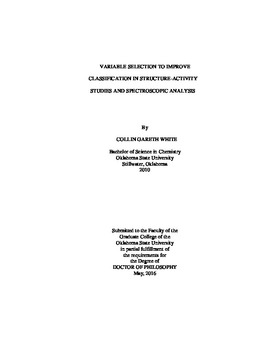| dc.contributor.advisor | Lavine, Barry K. | |
| dc.contributor.author | White, Collin Gareth | |
| dc.date.accessioned | 2017-02-22T22:10:59Z | |
| dc.date.available | 2017-02-22T22:10:59Z | |
| dc.date.issued | 2016-05 | |
| dc.identifier.uri | https://hdl.handle.net/11244/48889 | |
| dc.description.abstract | A genetic algorithm for variable selection to improve classifications is explored and validated on a wide range of data. In one study, 147 tetralin and indan musks and nonmusks compiled from the literature for the purpose of investigating the relationship between molecular structure and musk odor quality were correctly classified by 45 molecular descriptors identified by the pattern recognition GA which revealed an asymmetric data structure. A 3-layer feed-forward neural network trained by back propagation was used to develop a discriminant that correctly classified all of the compounds in the training set as musk and nonmusk. The neural network was successfully validated using an external prediction set of 37 compounds. In another study, 172 tetralin-, indan- and isochroman-like compounds were combed from the published literature to investigate the relationship between chemical structure and musk odor quality. The 20 molecular structural descriptors selected by the pattern recognition GA yielded a discriminant that was successfully validated using an external validation set consisting of 19 compounds. In a third study, the development of a prototype pattern recognition library search system for the infrared spectral libraries of the paint data query database to improve the discrimination capability and permit quantification of discriminant power for automotive paint comparisons involving the original equipment manufacturer is described. The system consists of two separate but interrelated components: search prefilters to cull the library spectra to a specific assembly plant and a cross correlation library search algorithm that utilizes both forward and backward searching to identify the year, line and model of the unknown in the spectral set identified by the search prefilters. The genetic algorithm was able to identify spectral variables from the clear coat, surfacer-primer and e-coat layers of the original manufacturer's automotive paint that were characteristic of the assembly plant of the vehicle. | |
| dc.format | application/pdf | |
| dc.language | en_US | |
| dc.rights | Copyright is held by the author who has granted the Oklahoma State University Library the non-exclusive right to share this material in its institutional repository. Contact Digital Library Services at lib-dls@okstate.edu or 405-744-9161 for the permission policy on the use, reproduction or distribution of this material. | |
| dc.title | Variable selection to improve classification in structure-activity studies and spectroscopic analysis | |
| dc.contributor.committeeMember | Rhinehart, R. Russell | |
| dc.contributor.committeeMember | El Rassi, Ziad | |
| dc.contributor.committeeMember | Gelder, John I. | |
| dc.contributor.committeeMember | Materer, Nicholas | |
| osu.filename | White_okstate_0664D_14551.pdf | |
| osu.accesstype | Open Access | |
| dc.type.genre | Dissertation | |
| dc.type.material | Text | |
| thesis.degree.discipline | Chemistry | |
| thesis.degree.grantor | Oklahoma State University | |
